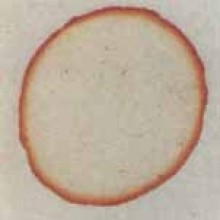Close observations of small phenomena sometimes leads to understanding of great science behind these effects and their exotic applications. The coffee ring effect is one of such effects. In Physics, a “coffee ring” is a pattern left by a puddle of particle-laden liquid after is evaporates. The phenomenon is named for the characteristic ring-like deposit along the perimeter of a spill of coffee. When a coffee is spilled on a solid surface, it leaves a dense ring-like stain along the perimeter called coffee ring effect. The image of a dried coffee stain left behind is a common household sight whenever a liquid in a container experience its natural evaporation. It is immediately apparent from the ring-like appearance of the stain that the majority of the residue is concentrated along the perimeter. This is intriguing because it indicates that some physical or chemical process is at work in drying drops which is able to segregate the solute from the solvent. Scientists [1,2,3] have attempted to answer the questions of how general is this phenomenon, what is driving mechanism responsible for it, and its practical technological implications?
Ring formation mechanism
From a simple physics point of view, the ring formation is because evaporation of water from a drying droplet does not take place evenly. It evaporates most quickly from the boundary between the liquid water, the solid surface, and the air – that is the edges of the droplet. This boundary is called the ‘three-phase boundary’. As water evaporates from the boundary, water from the rest of the droplet moves to take its place. This means that anything suspended in the water – such as coffee particles – is eventually deposited on this outer ring. Colloidal dispersions, such as paint, mud, or spilt wine or coffee, may dry into either a flat, uniform coating, or the solid phase may be deposited mostly at the edges, forming a ring. Surprisingly, we do not yet know what conditions discriminate between these two cases, or how to properly treat flow and transport in a drying droplet. Scientists are working to predict the shape of an arbitrarily dried two-phase fluid, and to understand the basic transport laws that are active during drying. By balancing the flux of particles and dispersant, and fluid drag against the substrate and particles, we can build a transport model that predicts the shape, scaling, and behaviour of the drying front. In a steady-state, this resembles the polarization region ahead of a filter, or the sedimentation of a column of silty water. Under more interesting conditions, deposits can form at the edge, in the middle, or in rippled patterns around obstructions.
Scientists [1-3] have determined that ring formation is a ubiquitous and robust phenomenon. It doesn't depend on the solute, the solvent, or the substrate so long as the solvent is partially wetting and volatile, and the contact line is pinned. Traditional mechanism of solute transport-Marangoni flow, Rayleigh-Benard convection, diffusion, electrostatic and electro-kinetic effects, and wetting phenomenon-do not account for ring formation. The phenomenon is due to a previously unexplored form of capillary flow: the contact line of the drying drop is pinned such that liquid evaporating from the edge must be replenished by liquid from the interior. Since evaporation is the driving mechanism, different deposits can produced by altering the evaporation profile. In case, when the evaporation profile is such that no water leaves from the edge no ring is formed.
Applications
Ring deposition is a potentially useful technology impacting printing, washing and coating processes with other application possibilities like fine wire assembly and DNA stretching. Using a colloidal suspension of gold particles it might be possible to assemble a fine wire with dimensions comparable to those achieved with modern lithographic methods. It might also be possible to stretch DNA using the strong shear flow that develops in ring forming drops when the evaporation rate is enhanced at the edge. The coffee-ring effect has implications for the manufacture of high tech materials such as fuel cells, displays, and sensors. Scientists in Germany have come up with an ingenious way to make water droplets dry evenly – avoiding the unwelcome ‘coffee-ring effect’, and paving the way for better and cheaper ways of making fuel cells and electronic devices. That’s because a lot of these devices are made by depositing a coating onto a surface, and one of the most popular ways of depositing a coating is by drop-casting – that is depositing lots of tiny droplets onto the surface. Drop-casting will be more familiar to most of us as ink-jet printing – these days a rather low-cost, low-tech method of depositing liquid onto a surface in defined patterns. If the drop-cast method can be perfected, it could lead to efficient, cheap solutions for the widespread production of a range of useful devices. Unfortunately the drop-casting method is subject to the coffee-ring effect. Each tiny droplet dries in a ring, making the surface uneven and affecting the performance of the device.
References
- R.D. Deegan, O. Bakajin T. F. Dupont, G. Huber, S. R. Nagel, and T. A. Witten, Capillary flow as the cause of ring stains from dried liquid drops, Nature 389, 827 (1997).
- L. Goehring, W. J. Clegg, and A. F. Routh, Solidification and ordering during directional drying of a colloidal dispersion, Langmuir, 26, 9269-9275 (2010).
- J. Li, B. Cabane, M. Sztucki, J. Gummel, and L. Goehring, Drying dip-coated colloidal films, Langmuir, 28, 200-208 (2012).
